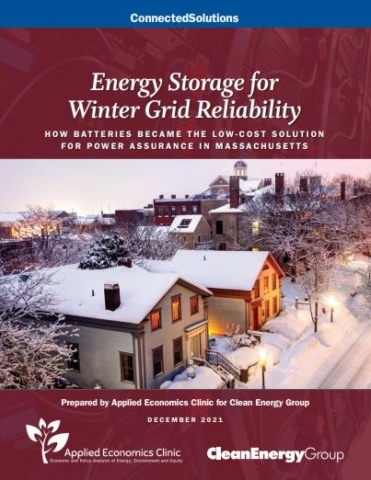Energy Storage for Winter Grid Reliability: How Batteries Became the Low-Cost Solution for Power Assurance in Massachusetts
December 2, 2021
Applied Economics Clinic | Clean Energy Group
Applied Economics Clinic (AEC) and Clean Energy Group (CEG) have released a new report that finds that customer-sited battery storage is by far the lowest priced new winter peaking resource now available to Massachusetts utilities; that payments to customers enrolled in the Commonwealth’s ConnectedSolutions battery program should be increased by at least 33 percent; and that program budgets should be expanded significantly.
The report, Energy Storage for Winter Grid Reliability: How Batteries Became the Low-Cost Solution for Power Assurance in Massachusetts, also finds that currently, the value of winter peaking capacity services from distributed (customer-sited) resources is incorrectly assumed to be $0 in the battery program cost-benefit analyses that determine performance payments to battery storage owners. The true value of these important services should be calculated and used in determining future winter seasonal performance payment rates for battery customers.
These changes need to be made immediately. Winter electric peaking capacity (called “winter reliability” in New England) provides an important value to the electric grid by helping to avoid winter season blackouts. As heating and transportation are increasingly electrified to meet climate goals, winter peak energy needs will grow; and as fossil-fueled generators are phased out due to emissions caps, new, clean sources of winter peaking capacity will need to be found.
The report introduces a winter reliability metric defined as the assurance of adequate electric capacity during periods of critical need. The authors calculate a “winter reliability value” measured as the net dollar value to supply any given peak supply technology (i.e., gas peaker or large-scale battery storage) on a per kilowatt-hour (kWh) basis during a CSC period. They then compare performance payments for customer-sited batteries, utility-scale batteries, solar PV+utility-scale batteries, and new gas peaker costs; the analysis shows that customer-sited batteries receive the lowest payments.
View more reports and resources related to the ConnectedSolutions program.





